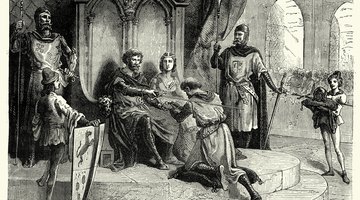Feudalism was a hierarchical system of land use and patronage that dominated Europe between the ninth and 14th centuries. Under Feudalism, a monarch's kingdom was divided and subdivided into agricultural estates called manors. The nobles who controlled these manors oversaw agricultural production and swore loyalty to the king. Despite the social inequality it produced, Feudalism helped stabilize European society. But in the 14th century, Feudalism waned. The underlying reasons for this included warfare, disease and political change. And when feudalism finally came to an end, so too did the Middle Ages.
The Hundred Years' War
To succeed, feudalism required considerable manpower. Vassals and serfs worked the manor year in and year out, bound by law to a lifetime of labor. But when war broke out between England and France in 1337, both nations undertook an unprecedented military buildup. This marked the start of the Hundred Years' War, a series of intermittent conflicts that lasted until 1543. In both countries, the army swelled its ranks with feudal laborers, undermining the manorial system while increasing the value of commoners by teaching them much-needed military skills.
The Black Death
Ten years after the Hundred Years' War began, the bubonic plague broke out in Europe. Spreading northwards from Italy, the bacterial infection known as the Black Death claimed at least a third of Western Europe's total population. With the young men of France and England off at war, agricultural output was already declining. Now there was a new challenge facing feudalism. Manor after manor suffered devastating losses. Conditions were so severe, in fact, that waves of laborers ran away to larger cities, an act that would have once been punishable by law.
Political Changes
Feudalism was a coercive system that granted few individual liberties. Ancient laws kept peasants tied to the land, making their labor compulsory. Yet over time, concepts of individual rights gradually gained footing, especially in England. The 12th century reforms of Henry II, for instance, expanded the legal rights of a person facing trial. In 1215, King John was forced to approve the Magna Carta, a document obligating the crown to uphold common law. Eighty years later, Edward I finally extended parliamentary membership to commoners. These developments gradually made the concept of agricultural servitude appear inexcusable.
Social Unrest
By the 1350s, war and disease had reduced Europe's population to the point that peasant labor had become quite valuable. Yet conditions for the serfs themselves remained largely unchanged. They were still heavily taxed on wages kept artificially low. Unable to survive in these circumstances, Europe's peasantry revolted. Between the 1350s and the 1390s, uprisings took place in England, Flanders, France, Italy, Germany and Spain. After an English revolt in 1381, Richard II promised to abolish serfdom. Though he later failed to keep his word, serfdom nonetheless died out in the next century.
End of the Middle Ages
The end of serfdom meant the end of feudalism itself. Europe's manors could no longer function without a labor supply. As feudalism faded, it was gradually replaced by the early capitalist structures of the Renaissance. Land owners now turned to privatized farming for profit. Laborers began demanding - and were given - better wages and additional liberties. Thus, the slow growth of urbanization began, and with it came the cosmopolitan worldview that was the hallmark of the Renaissance.
Related Articles
References
Resources
Writer Bio
A longtime author of lifestyle articles, Gregg Newby has written extensively on personal finance, health and wellness, fitness, education, and more. His work has been syndicated by several major news websites, including FOX, CBS, and Accuweather. Newby holds a master's degree in history and is an ardent pluviophile.











